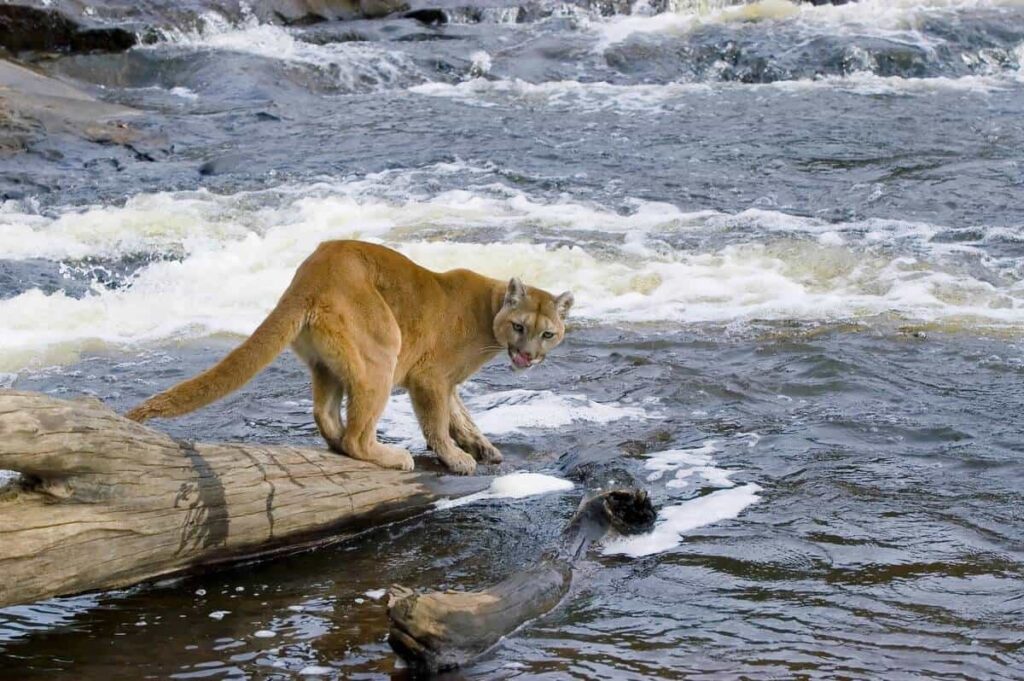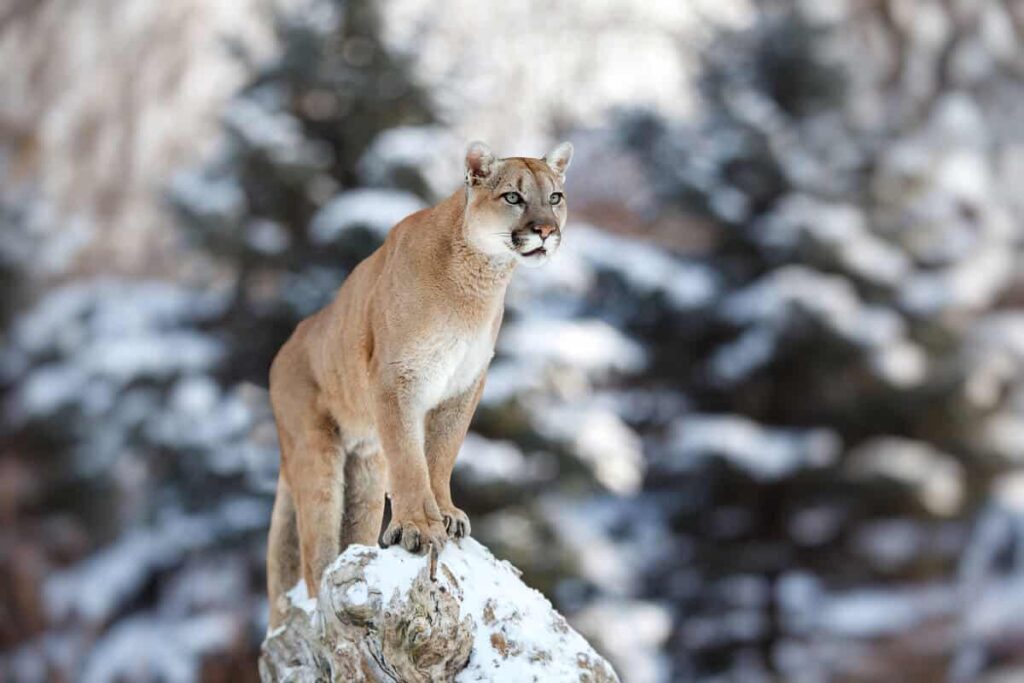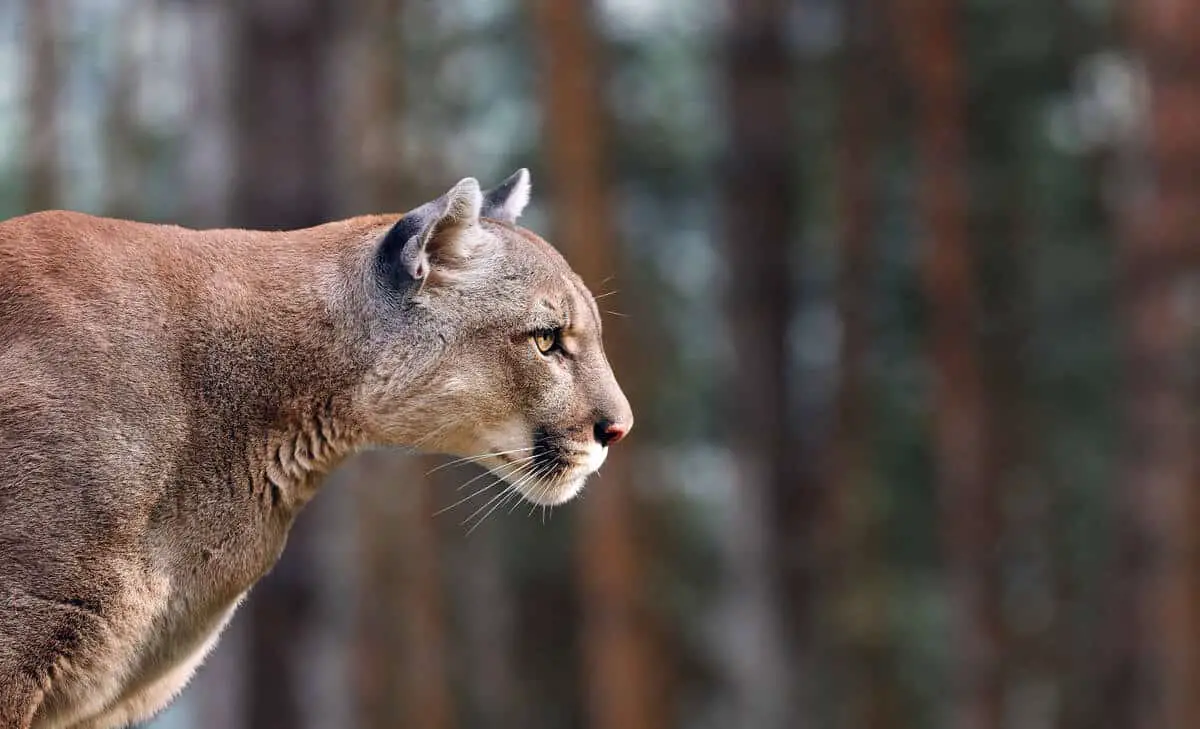They’re beautiful, large, ferocious, fast, strong, and part of Banff National Park. I’m talking about cougars. While you’re not likely to see one, it’s still good to know about their behavior and what to do in case of an encounter. If you wanna learn more about it, this article is for you.
While Banff is known for its black and grizzly bear populations, the elusive cougar (Puma concolor) is the other big predator that people fear. Also known as mountain lion, panther, and cougar, this big cat roams primarily the forests and mountains of the park.
Although they have a secretive nature, there are occasional encounters and sightings, especially in the park’s more remote areas. During the two years I was living in Banff I never saw one, and that’s probably a good thing…
Anyhow, cougars are essential to the park’s ecosystem. They play a vital role in maintaining the balance of prey populations, such as deer and elk. If you’d like to know more about these beautiful creatures in Banff, I invite you to read on!
Cougars in Banff: General Overview
Habitat and Range
Cougars thrive in different kinds of habitats in Banff National Park. These adaptable cats can dwell in forests, mountain areas, and valley bottoms. You’ll find them navigating steep terrains and using infrastructure like highways within the park.
Characteristics
A mature cougar has a muscular physique. An adult cougar typically measures 5-9 feet from nose to tail. Males generally weigh in at around 140-200 pounds, while females tend to be smaller at 70-115 pounds.
Their tawny coat helps camouflage them against the forest floor, making it easier to stalk their prey.
Cougars can live up to 12 years in the wild.

How Many Cougars Are There in Banff National Park?
Unfortunately, it’s not known how many cougars live in Banff National Park. Estimates for the province of Alberta range from 2,500 to 3,000. The provincial government regulates the cougar population. The annual cougar hunting quota is currently 155.
Cougars and People in Banff
What to Do in Case of an Encounter?
Cougars are shy animals, and they usually avoid people. But if you happen to encounter a cougar, it’s essential to know how to react. By following these guidelines, you can improve your chances of a safe encounter:
- Stay calm. Maaintain eye contact with the cougar, and avoid making any sudden movements.
- Back away slowly. Slowly backing away will demonstrate that you’re not a threat, but do not turn your back on the animal.
- Appear larger. Raise your arms, open your jacket, or stand on your tiptoes.
- Do not run. Running can trigger a cougar’s chase instinct. Instead, stand your ground.
- Maintain eye contact and make yourself seem less of an easy target.
- Speak in a loud, firm voice to assert your presence.
- In the unlikely event of an attack, fight back using any available tools or weapons, such as rocks or sticks, to defend yourself. Cougars are more likely to flee if they feel threatened.
Precautions to Take for Cougar Encounters in Banff
You can take some simple precautions to decrease the likelihood of encountering a cougar:
- Travel in groups. Cougars are less likely to approach multiple people together, so having a few hiking buddies can offer you some protection.
- Keep children close. Ensure kids play and walk close to adults, as (small) children might be more attractive prey.
- Be aware of your surroundings. Look out for any signs of cougar activity, like tracks or kills.
- Avoid hiking during dawn and dusk. Dawn and dusk are prime hunting hours for cougars, so hiking during daylight is best.
- Stay on designated trails: Avoid venturing off into unmarked or closed areas. This increases your chances of accidentally stumbling upon a predator’s territory.
- Keep a clean campsite. When camping in the park, store your food and scented items in bear-resistant containers or hang them from trees at least 10 feet off the ground and 4 feet away from the trunk. This reduces the chances of attracting cougars (and bears) to your campsite.
- Carrying bear spray is also a good idea. It can be an effective deterrent for both bears and cougars. Ensure you know how to use it properly and keep it easily accessible, as you might not have much time to react in an encounter.
Understanding Cougar Behavior and Signs of Presence
When exploring Banff, you might come across signs that cougars are nearby. Some things to keep an eye out for include distinctive tracks in the snow or mud and scratching posts on trees where cougars mark their territory.
You may also find plucked fur and carcasses, such as deer or elk, from their prey.
If you see any of these signs, be careful! Cougars are masters of camouflage, and just because you don’t see them doesn’t mean they are not around. Luckily, cougars have no reciprocal behavior, meaning they usually remain elusive.
Cougars are solitary hunters and are known for their stealth and ambush tactics. They usually hunt at dusk or dawn and prefer to attack from behind, leaping onto their prey.

How Common Are Cougar Sightings Within the Park?
As cougars are elusive animals, it’s rare to catch a glimpse of one during your visit to Banff National Park.
In recent years, there has been an increase in reported sightings. However, spotting a cougar in the park is still relatively uncommon.
What Are the Chances of Encountering a Cougar while Hiking in Banff?
A study conducted on predator risk in Banff National Park found that cougar predation risk was lower when compared to other predators, such as wolves and bears. Additionally, another study supports the fact that limited trail use by cougars decreases the chances of an encounter while you’re hiking.
Are there any Specific Areas with Higher Cougar Activity in Banff?
While exploring Banff National Park, you might wonder if there are specific areas with higher cougar activity. The answer is yes; there are particular locations where cougars are more active.
In one study, researchers found that cougars use underpasses more frequently than other wildlife crossing structures like overpasses. Like the Edith underpass, these crossings provide a safer passage for cougars across the busy Trans-Canada Highway.
So, it’s worth watching for signs of cougar activity if you’re near underpasses (which you probably shouldn’t be as they’re not meant for humans).
Another observation from yet another study shows that cougars often move to more remote parts of their home ranges when gray wolves are in the area. Under these circumstances, they have both been observed switching prey in the Bow River Valley.
Human development and highway construction in Banff can also affect cougar activity. Research has shown that cougar activity is primarily nocturnal at wildlife crossings and backcountry sites.
How Does the Banff Park Management Handle Cougar Populations and Safety?
Banff National Park’s management uses strategies to maintain a healthy cougar population and promote safety. That’s why park officials monitor cougar numbers, movements, and interactions with other wildlife.
This monitoring helps balance the predator populations and their prey, which is essential for the Banff ecosystem’s overall health.
Regarding visitor safety, there are informative signs in the park that advise how to safely encounter cougars and other wildlife upon entering the park.
These guidelines provide information on cougar behavior, signs of their presence, and what to do if you ever encounter one (or you can read this article!)
In case of a close encounter with a cougar or any other potentially dangerous situation, the park management has emergency response procedures. For example, this could involve temporarily closing specific areas of the park.

Cougar Attacks in Banff National Park
There have been a few instances where cougars have shown aggressive behavior toward people in the park. This can be due to several factors, like hunger, illness, or a perceived threat.
Cougar Conservation Efforts in Banff National Park
Protecting Cougar Habitats in Banff
One way to protect cougars in Banff National Park is by preserving their habitats, which actually benefits not just cougars but all wildlife in the park.
This comes down to supporting the conservation of forests, riparian areas, and prey populations so cougars have a suitable environment to thrive in.
Another method of conserving cougar habitats in the park is using wildlife crossings along the Trans-Canada Highway. These big, concrete structures help cougars and other wildlife cross the road safely. It also connects their habitats. You’ll find a big wildlife crossing between Banff and Lake Louise on the Trans-Canada Highway. You can’t miss it.
Addressing Threats to Cougars in Banff
Cougars in Banff National Park face various threats, and one of the most significant is interactions with other large predators, such as gray wolves.
This can lead to so-called interference competition, with wolves taking over cougar kills or killing cougar themselves. By understanding and reacting to these interactions, park management can help ensure the survival of both species in the park.
Another serious threat to cougars is the fragmentation of their habitat by highways and other disturbances. That’s why the park management tries to mitigate the effects of highways and habitat fragmentation to maintain a healthy cougar population.
Research and Monitoring Program in Banff
Tracking Cougar Populations
Several data collection techniques are used to track the cougar population in Banff National Park. They include:
- Remote Cameras: Strategically placed cameras capture images of cougars moving through the area. This helps park officials estimate their population size and determine which areas they frequent.
- GPS Collars: Some cougars are fitted with GPS collars, allowing researchers to track their movements and study their habitat use. This method provides insights into their daily lives, including their hunting and mating patterns.
- Public Reporting: You can contribute to the program by reporting any cougar sightings or encounters to park officials. Your reports help researchers better understand cougar activity.
Cougars’ Ecological Role in Banff
Predator-Prey Relationships
In Banff National Park, cougars play a vital role in maintaining a balanced ecosystem. As so-called “apex predators”, they help regulate the populations of various prey species, such as deer, elk, and bighorn sheep. Interactions between cougars and gray wolves are also essential to the park’s complex predator-prey dynamics.
Cougars are known to hunt on their own, allowing them to hunt various prey. Unlike pack-hunting wolves, cougars rely on their stealth and powerful pounce to catch their prey.
This hunting strategy can affect prey populations differently, enabling cougars to take down smaller, more agile animals and larger, slower ones.
Relationships between cougars, prey, and other predators can change over time for many reasons. For example, increasing the wolf population might change how cougars and wolves interact and share resources. This could affect prey populations and species distribution across the park.

